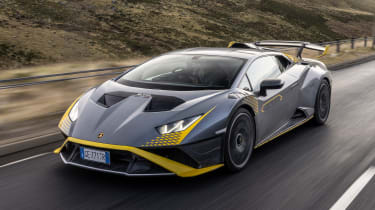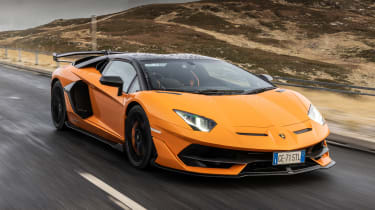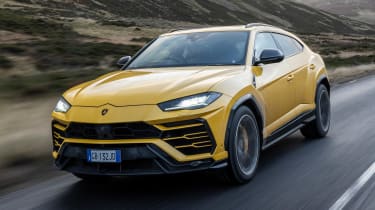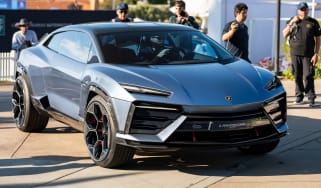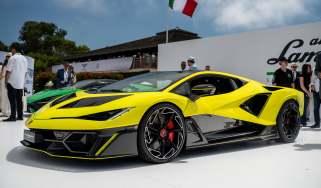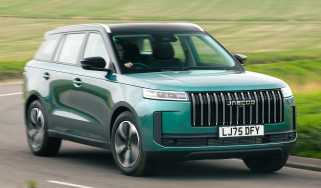End of an era: driving the last of the petrol Lamborghinis
Electrification spells big changes for Lamborghini, but there’s still time to enjoy its petrol-powered cars
The coming years will bring a seismic shift for one of the world’s best-loved supercar makers. Lamborghini, a brand founded on show-stopping designs and double-digit cylinder counts, will be forced to electrify its line-up. By the end of 2024, the brand’s entire range will feature hybrid propulsion, and the first-ever fully electric models from the company will arrive not much later.
Perhaps more than any other manufacturer, Lamborghini will be fighting to keep hold of its identity in the EV era. But today, as electrification becomes increasingly common in the automotive industry, the Italian marque’s range of pure-petrol thoroughbreds is here to be enjoyed. So we strapped into cars such as the Huracán STO, Aventador SVJ and the Urus SUV and headed to Scotland, to sample the very best that Sant’Agata offers today.
But first, let’s consider what lies ahead. With the demise of the combustion engine, Lamborghini has some work to do. Its cars are defined by wailing engines and flame-spitting exhausts, and although electrification is more than welcome in a family SUV, you might argue it’s less appealing in a soul-stirring supercar.
Of course, Lamborghini will continue to provide piston-engine thrills with a fully hybrid line-up by the end of 2024, but the EV switch isn’t far away. For the time being, at least, things look promising. Part of Lamborghini’s “celebration of the combustion engine” will see the launch of a new V12 model next year, which will likely join the reborn Countach as a limited-run special. A hybrid-powered replacement for the Aventador will arrive in 2023, along with an electrified Urus and hybrid Huracán successor before the end of 2024.
With these, the combustion engine will continue to take centre stage. The electric element of the powertrain will serve to enhance the petrol units, filling torque gaps, adding performance and improving response. These cars should be just as characterful and even more exhilarating than the current models, according to Lamborghini’s boss of Europe, the Middle East and Africa, Francesco Cresci – and you can read more about what he thinks of the firm’s electrified future and how Lambo will tackle it below.
The idea of a fully electric Lamborghini, which will arrive in the mid-2020s, is more challenging, however. Cresci told us that the company is “working out how to give an identity to our product, and making sure that it fits our DNA”.
But we can be fairly confident that Lamborghini will continue to produce characterful ICE cars in some form or another. In an all-electric future, these will be track-only models in the mould of the Essenza SCV12. Cars that still capture the brand’s original spirit – and few do it better than the three models we’ve lined up here.
Lamborghini Huracan STO
| Model: | Lamborghini Huracan STO |
| Price: | £260,012 |
| Engine: | 5.2-litre V10 petrol |
| Power: | 631bhp |
| Torque: | 565Nm |
| Transmission: | Seven-speed dual-clutch auto, rear-wheel drive |
| 0-62mph: | 3.0 seconds |
| Top speed: | 193mph |
Lamborghini’s DNA is alive and well in the firm’s latest hardcore model, the Huracán STO. Quite simply, the track-bred STO is the pinnacle of the Huracán story, and a send-off to the sports car that’s been with us since 2014.
The 5.2-litre V10 may produce the same 631bhp as the Huracán Performante, but the chassis has been reworked, and the body has been tweaked and contorted to produce 420kg of downforce at 174mph. With a carbon-fibre body, a lighter windscreen and magnesium wheels, it weighs in at 1,339kg (dry), 43kg less than the Performante.
To my eyes, the wings, scoops and colourful graphics don’t do the styling any favours, but my word, does it look purposeful sitting among Scottish mountains. Lamborghinis don’t get much more serious than this. After all, STO stands for ‘Super Trofeo Omologata’, referring to the company’s one-make race series.
Inside, there’s no mistaking this for anything other than a road racer, with Alcantara covering the steering wheel, dash and seats. The door panels are single-piece carbon-fibre items, featuring fabric door handles; contrived, perhaps, but not out of place in what is a genuine thoroughbred.
It might not be Monza, but the Glenshee pass poses a stiff challenge. The STO must tackle the tight twists and bumps of the Scottish Highlands as well as it eats up the Ascari chicane if it is to rank among the all-time great Lamborghinis. It does just that.
On the road, it’s unhinged, combining ballistic speed with sharp, uncompromising dynamics like very few cars on sale. The aggressive set-up means that on anything other than smoothly surfaced roads, it fidgets and relays every contour of the tarmac to the driver, but the suspension rounds off the worst of the jolts, leaving the car feeling pleasingly connected when you need it most. The steering is beautifully precise, feeding your hands with information without being overly distracted by cambers and ruts.
It really does feel “right” – and then you unleash the V10’s firepower. Switch to Trofeo mode and the exhaust note takes on a deeper, more hard-edged rumble, so the motor can sing to full effect. Reaching a piercing crescendo at 8,500rpm, the STO is fantastically loud, and the accompanying hit of acceleration is savage. Like all Huracáns, the STO uses a dual-clutch gearbox; batting away at the column-mounted paddles is a joy, with super-fast upshifts and perfectly matched downchanges.
Power is sent to the rear wheels alone in the STO, and temperatures were barely above freezing in the Highlands at the time of our photoshoot. The STO demands respect, of course, but it stops short of being truly intimidating.
With the ESC in Trofeo mode it invites you to throw as much power as you dare at the rear tyres, the car scrabbling for grip, feeling totally alive, without getting away from you. The precise throttle response and communication through the chassis make this all the more absorbing.
As a farewell to the Huracán and its V10 engine, the STO is a masterpiece. It’s peak modern Lamborghini, with all the excitement you’d expect – and then some – dressed with a layer of dynamic class. The Huracán’s hybrid replacement has a serious task on its hands.
Lamborghini Aventador SVJ
| Model: | Lamborghini Aventador SVJ |
| Price: | £360,000 |
| Engine: | 6.5-litre V12 petrol |
| Power: | 759bhp |
| Torque: | 720Nm |
| Transmission: | Seven-speed auto, four-wheel drive |
| 0-62mph: | 2.8 seconds |
| Top speed: | 217mph+ |
If the Huracán STO is the most extreme iteration of a V10 Lamborghini, the Aventador SVJ is the most extreme series-production Lambo of them all. The Aventador has been with us for a decade, and the SVJ elevates what is now a dated package for maximum performance. With four-wheel drive, a dozen cylinders and 759bhp – a full 29bhp more than the Aventador S – its potency every inch matches its wild styling.
Slot yourself into the Aventador and it’s intimidating, just as a Lambo should be. Cocooned by the high centre console, you peer through an extremely narrow windscreen, the A-pillars obstruct your view and rearward visibility is pretty much non-existent. The cockpit fizzes to the sound of the V12’s energy, but the Aventador SVJ is a clumsy car at low speeds. The single-clutch robotised gearbox feels archaic, and making smooth progress requires finesse.
What the SVJ really needs is fast, flowing A-roads to stretch its legs, and uncorking that V12 for the first time is eye-widening. The response is immediate, the noise all-consuming; the Aventador SVJ claws at the tarmac and doesn’t let up. When it’s time to grab another gear at 8,700rpm, the shifts are rapid and send a violent jolt through the car as the next ratio slams home. It’s physical and involving, like very few other modern supercars.
At speed, the steering wheel tugs at your hands as the SVJ’s front wheels hunt for cambers due to the aggressive suspension geometry. It’s best to lighten your grip and let the car feel its way along. Grip levels are seemingly unapproachably high on the public road; turn-in is supremely sharp and through smooth, high-speed corners the SVJ really begins to work. Staying flat and composed it’s able to carry huge speed, while always offering a precise, connected feeling.
The SVJ’s full potential simply can’t be reached on the road, but during those short bursts, it leaves a mark. It’s nowhere near as polished as other modern supercars – the STO included – but for sheer intensity, few can match it.
Lamborghini Urus
| Model: | Lamborghini Urus |
| Price: | £169,110 |
| Engine: | 4.0-litre twin-turbo V8 petrol |
| Power: | 631bhp |
| Torque: | 850Nm |
| Transmission: | Eight-speed auto, four-wheel drive |
| 0-62mph: | 3.6 seconds |
| Top speed: | 190mph |
Where the SVJ is tasked with distilling all that drama into a usable road-going package, the Urus must squeeze as much excitement as possible from its Audi-derived underpinnings to succeed as a Lamborghini. Porsche, Aston Martin, Maserati (and soon Ferrari) have each been forced to respond to the current performance-SUV craze, blending sports-car athleticism with the space and usability of a 4x4. The Urus is Lamborghini’s take, and conceptually, it’s the model best suited to electrification in the future.
Of course, it’s not Lamborghini’s first SUV. That accolade went to the LM002 in 1986, an equally divisive off-roader, and like its ancestor, the visual impact of the Urus is undeniable; the Urus is a hulking, menacing machine, and looks like no other SUV, for better or for worse. With fussy detailing and awkward slashes in the bodywork, the Urus trades elegance for steroidal, brutish looks.
The cabin tech is light years beyond its supercar siblings, though. The Urus borrows its infotainment system from the Audi Q8 (albeit with Lamborghini-specific graphics) and it’s far more intuitive than the Huracán’s portrait-orientated touchscreen. The less said about the Aventador’s ageing set-up – which you’d recognise from a 2009 Audi A4 – the better. But as we’ve found out, that car’s beauty is the mix of feral character and technology that involves you; CarPlay isn’t at the forefront of your mind when you’re driving the SVJ. By contrast, the Urus is hushed at speed and a pleasant motorway companion, which can’t be said of many Lamborghinis, not least the other two on this test.
Switch into Corsa mode, drop a few ratios on the eight-speed automatic gearbox and the Urus ruthlessly deploys all 641bhp from its 4.0-litre twin-turbocharged V8. The straight-line punch is of supercar proportions; the 2.2-tonne Urus blasts from 0-62mph in just 3.6 seconds, and on this alone, it absolutely feels worthy of the Lamborghini badge. It may not shriek like a naturally aspirated motor, but the thunderous, crackling exhaust note is addictive. Yet the Urus’s biggest trick is the way it bullies the road at any speed, in all conditions. Across broken, slippery Scottish tarmac you can commit harder than in the STO or the SVJ; in truth, it’s probably the quickest of the trio across the ground when the temperature is hovering as low as it is.
For such a tall, heavy car, the body is kept tightly in check over undulations, and traction is imperious. In Corsa mode, you can chase the throttle, with the Urus squatting on its back axle and finding supreme traction. The steering doesn’t feel particularly positive, and the ride is busy at times, but it feels every inch the Lambo of SUVs.
The Urus was the car that brought Lamborghini into a new market segment that the brand pretty much coined with the LM002, protecting its profits for future generations. The company will have to make another big step with electrification, but if its current line-up is anything to go by – and as we’ve heard from Cresci – the future is very bright for the brand from Bologna.
5 most iconic Lamborghinis
Lambo has always been among the supercar front runners. We take a look at five of its finest models.
Lamborghini Miura P400
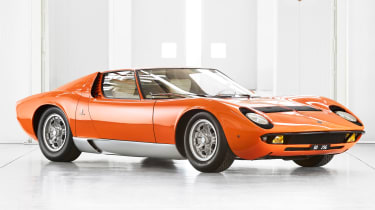
More than any other, the Miura is the car that defined Lamborghini, and sparked a lineage of breathtaking mid-engined V12 halo cars. It was penned by legendary designer Marcello Gandini, who crafted a supercar that sent tremors all the way to Ferrari’s Maranello HQ in 1966. Powered by a 3.9-litre “Bizzarrini” V12, the Miura was the fastest production car on the planet when released, topping out at 174mph.
Lamborghini Countach LP5000 Quattrovalvole
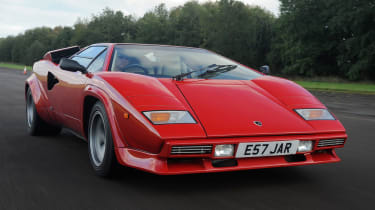
The Miura would always be a difficult act to follow, but the Countach arguably bettered it. Throughout an astonishing 16-year life span, the Countach morphed from a svelte, wedge-shaped supercar into a bewinged monster in LP5000 Quattrovalvole guise. With 449bhp on tap, the QV had more than enough go to match all that show.
Lamborghini Diablo 6.0 VT
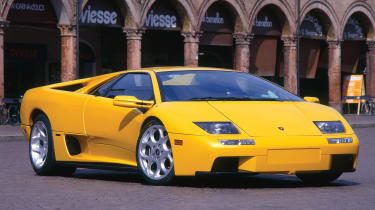
Does any car bear a more intimidating name than the Lamborghini Diablo (devil in Spanish)? That moniker suggests an unforgiving blend of V12 fury and spiky handling, but with the 6.0 VT, Lamborghini produced a satisfying, rounded supercar. Under Audi ownership, the Diablo’s jaw-dropping design was refined, and a top speed of 208mph meant the VT was never wanting for pace.
Lamborghini Murcielago LP670-4 SV
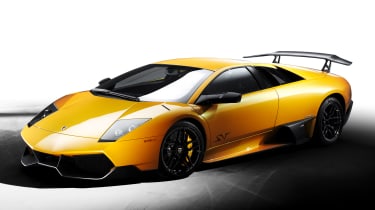
The Murcielago LP670-4 SV marked the last hurrah for the Bizzarrini V12 used in Lamborghinis since 1963, and quite a send-off it was. With more power, less weight and a set of stealthy matte black aero devices, the SV was a seriously hardcore version of the Murcielago, firing from 0-62mph in just 3.2 seconds.
Lamborghini Huracán Performante
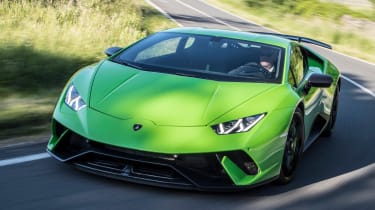
When it was launched in 2014, the Lamborghini Huracán certainly provided the aural and visual drama we’re used to from the marque, but something was missing. That something was provided by the Performante version, which took the Huracán’s dynamics to new levels, and set off an impressive run of form with the subsequent EVO and STO models. A production-car lap record of 6:52 at the Nürburgring wasn’t half bad, either.
Q&A: Lamborghini’s future
Interview with Francesco Cresci, EMEA regional director, Lamborghini

We took time out from driving Lamborghini’s models to speak to Europe, Middle East and Africa boss Francesco Cresci about what the future holds for the Italian brand.
Q: Electrification is on the horizon for Lamborghini. The entire range will be electrified by 2024 and we’ve already seen mild-hybrid vehicles with the Sián and new Countach. Will these new models be plug-in hybrids or self-charging hybrids?
A: “At the moment, the project is not finalised. But I can tell you that they won’t be mild-hybrid, and we are going to use the addition of electric power to improve acceleration and to improve driving dynamics. With an electric motor, you can cover torque holes of the combustion engine, making it much more exciting.”
Q: With the Urus and Huracán, we see platform and engine sharing with the wider Volkswagen Group. Given the group’s investment and research into electrification, will you utilise the knowledge and platforms from Lamborghini’s sister firms for future electrified models?
A: “We’d be crazy not to take advantage of being part of one of the world’s largest automotive groups. We’ll definitely have many kinds of platforms and other elements that we can pick from them. We’ll take what we think fits our brand and DNA. This is also a competitive advantage compared with other automotive brands.”
Q: The combustion engine is the heart of a Lamborghini. A fully electric Lamborghini will lose an element that defines the car, so how will the brand separate itself from other electric performance cars? What will make the electric model a Lamborghini?
A: “It’s difficult to answer, the full-electric car is quite far away right now. The technology is evolving rapidly. At the moment, the investment from the automotive industry is incredible; what wasn’t possible five years ago is now feasible. So there’s much more to come in the next five to 10 years. Working out how to give an identity to our product, and making sure that it fits the company’s DNA, is an ongoing process. You can characterise an electric car, for sure, by making the emotion you get from it specific to our brand.”
Q: What about alternative fuels? Could this be an avenue for Lamborghini to continue with combustion engines?
A: “For sure, electrification is the current trend and direction of the industry, but we are also evaluating other options such as biofuels and synthetic fuels. These are options we are evaluating to keep the combustion engine alive, but at the same time keeping emissions at the correct level. We want to preserve this and make sure that when you buy a Lamborghini, you’re buying a car with the characteristics and DNA of a Lamborghini.”
Q: Will regulations limit the brand from producing small volume or one-off cars powered by combustion engines?
A: “Regulations are becoming tougher and tougher, and we need to make sure we comply with them. It’s difficult to say, because we need to make products that comply with regulations all around the world, and they vary quite a lot by country. When governments fix the rules, they will fix the rules for everybody, and I don’t believe they will give us special treatment. I hope they do, but I’m quite sure that they will not.”
Q: Track-only specials are a way of preserving the combustion engine, as we’ve seen with the Essenza SCV12, for example. Will these cars be more common in the electric future, when you can’t build ICE production cars?
A: “The answer to this is quite far away at the moment. The world is evolving, so it really depends on if, for example, synthetic fuels and biofuels can become a reality, because this will change the situation completely. Of course, if we commit to electric vehicles there will definitely be a niche for combustion-engined track-only cars.”
Q: The flagship Aventador uses a carbon- fibre structure, but the Huracán uses an aluminium chassis. Is it possible that the hybrid Huracán replacement will use a carbon-fibre structure to compensate for the weight penalty of electrification?
A: “This is definitely an option. In general, we have carbon fibre available because we produce it at the factory, so extensive use of carbon fibre will be a key element in reducing weight due to batteries and so on. Now, for which platforms we will use carbon fibre more extensively is difficult to say, because it depends on what kind of mission the product has. In some cases you don’t need the extra stiffness, in other cases you do. For example, we use it in the Aventador,
What's favourite Lamborghini? Tell us about it in the comments section below...
Find a car with the experts



